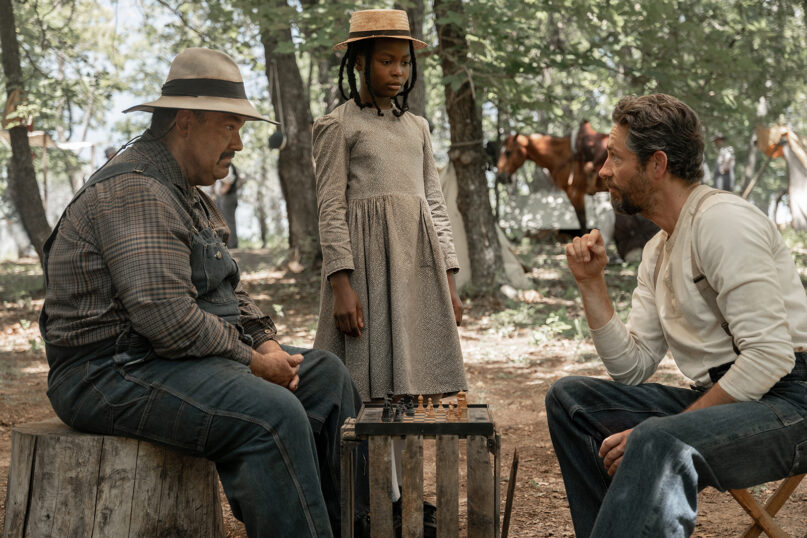(RNS) — A new movie about a faithful little girl, oil and Oklahoma shares seldom-heard Black history.
Sarah Rector, the title character of the biographical film “Sarah’s Oil,” was born in 1902 in Oklahoma Indian Territory and, like other African Americans in that time and place, was a descendant of Creek Freedmen, who were enslaved by the Muscogee (or Creek) Nation. She was allotted 160 acres of land under the Dawes Act, and at 11 years old, the film depicts her as being certain that God has told her there is oil underneath it.
The movie, which opens in theaters (Friday) Nov. 7, was inspired by the 2014 book “Searching for Sarah Rector: The Richest Black Girl in America” and is a joint project of Amazon MGM Studios and two faith-based studios, Wonder Project and Kingdom Story Co.
“Most people thought the land was worthless — no good for anything but tomatoes and snakes,” Sarah says in the movie, where the main character is portrayed by actress Naya Desir-Johnson. “My pa said we had to sell it. But I was determined to keep it.”
RELATED: As ‘What If…’ returns to theaters, Dallas Jenkins recalls finding his Christian movie calling
The movie, dubbed “inspired by a true story,” also depicts oil company executives, a judge and wildcatters, such as one portrayed by Zachary Levi, known for playing the lead character in the NBC series “Chuck.” His character, Bert, joins forces with Sarah to see if her belief in the riches of her land would be proven true.

Adyan Copes as Junior, from left, Sonequa Martin-Green as Rose Rector, Kenric Green as Joe Rector, and Naya Desir-Johnson as Sarah Rector in “Sarah’s Oil.” (Photo by Shane Brown/Amazon MGM Studios)
She turns out to be a rare recipient of a plot whose contents quickly made her a millionaire at a young age.
Sarah’s family eventually moved from Oklahoma to Kansas City, Missouri. Her real-life nieces said the faithfulness shown in the movie by Desir-Johnson and husband-and-wife actors Kenric Green and Sonequa Martin-Green, who portray her parents, is reminiscent of her real forebears.
“I believe the way that our grandparents, Joe and Rose Rector, stood behind her and supported her because as we were growing up, we felt that same thing from all of her siblings,” said Debbie Brown, one of three nieces who spoke with Religion News Service about their aunt. “When it was in the movie, it was like, ‘Oh, my God, I’m reliving my childhood’ because the way they were with God, with believing, with trusting, that was handed down, and we felt that from them and learned from them.”
In a 1914 letter, posted on the website of a Kansas City NPR station, a Muskogee County Court judge attested to visiting Sarah’s family “as soon as oil was discovered.” The letter, addressed to W.E.B. Du Bois, co-founder of the NAACP’s magazine The Crisis, detailed how the judge worked with Sarah’s family, a white guardian the judge said had been selected by the family, and a lawyer to make arrangements for them to build “a suitable house for the family to live in” since they could now afford more than the “small shack” that was then their home.
In the film, Sarah is shown traversing the property with her dog, lying on the ground, listening beneath it and expressing her certainty about its future. “I believe the good Lord put it in my head,” she proclaims. “I heard it loud and clear. I heard it churning and swirling underground like a fast-moving river. I knew what it was.”
Though the movie is filled with humor and excitement, it also reveals the racism and violence that accompanied the desire for oil and the riches it could bring. When Sarah’s mother learns that two other children who owned plots were murdered, she begins to question her daughter’s partnership with a wildcatter.
“You’re the one got us in this,” says an emotional Martin-Green to Levi in the movie. “And I don’t know if you are God-sent or hellbound, but that girl is the salt in my earth and the sun in my sky. Nothing happens to her.”
The murder of the children, Herbert and CaStella Sells, who died after their house was set on fire, led Sarah’s family to head north.
“It was my grandparents that decided to move the family to Kansas City,” said Rosina Graves, another niece. “I believe it was for safety’s sake for the family because if they killed the Sells children for the very same thing, of the oil on their property, then that’s why my grandmother and my grandfather decided that they would move our family from Oklahoma.”
Donna Brown-Thompkins, the youngest of the three nieces interviewed, was a preteen when Sarah Rector died in 1967 and was buried in Taft, Oklahoma, an all-Black town in Muskogee County. Brown-Thompkins recalled that Rector didn’t tend to stand out by dressing differently from their mother and other aunts. But Brown-Thompkins said no one else on her rich aunt’s block “had a big, pretty shiny Cadillac.”

Mel Rodriguez as Mace, from left, Naya Desir-Johnson as Sarah Rector and Zachary Levi as Bert Smith in “Sarah’s Oil.” (Photo by Spencer Click/Amazon MGM Studios)
Today, a building in Kansas City known as Rector Mansion awaits restoration after receiving a $75,000 grant in 2021 from the National Trust for Historic Preservation. Sarah Rector once hosted entertainers Duke Ellington and Count Basie there.
“At the top of the Rector Mansion was a ballroom,” Brown said. “The whole family lived there, but she still entertained at the top of that mansion.”
The nieces said they relished participating in the recent red carpet event when “Sarah’s Oil” premiered in the city where Rector lived most of her life.
“What I enjoyed was telling our story — getting the correct story out there because there’s so much out there that’s still wrong,” said Graves, noting that some photos posted online that are described as depicting her aunt, in fact, do not. “Any opportunity that we get to share the correct information is what we like because we worked way too long — hours, money and time — to correct it, and still, people want to tell their version. I’ll just put it that way, their version of what’s not correct.”
RELATED: Harriet Tubman, in movie and real life, guided by faith in fight for freedom


